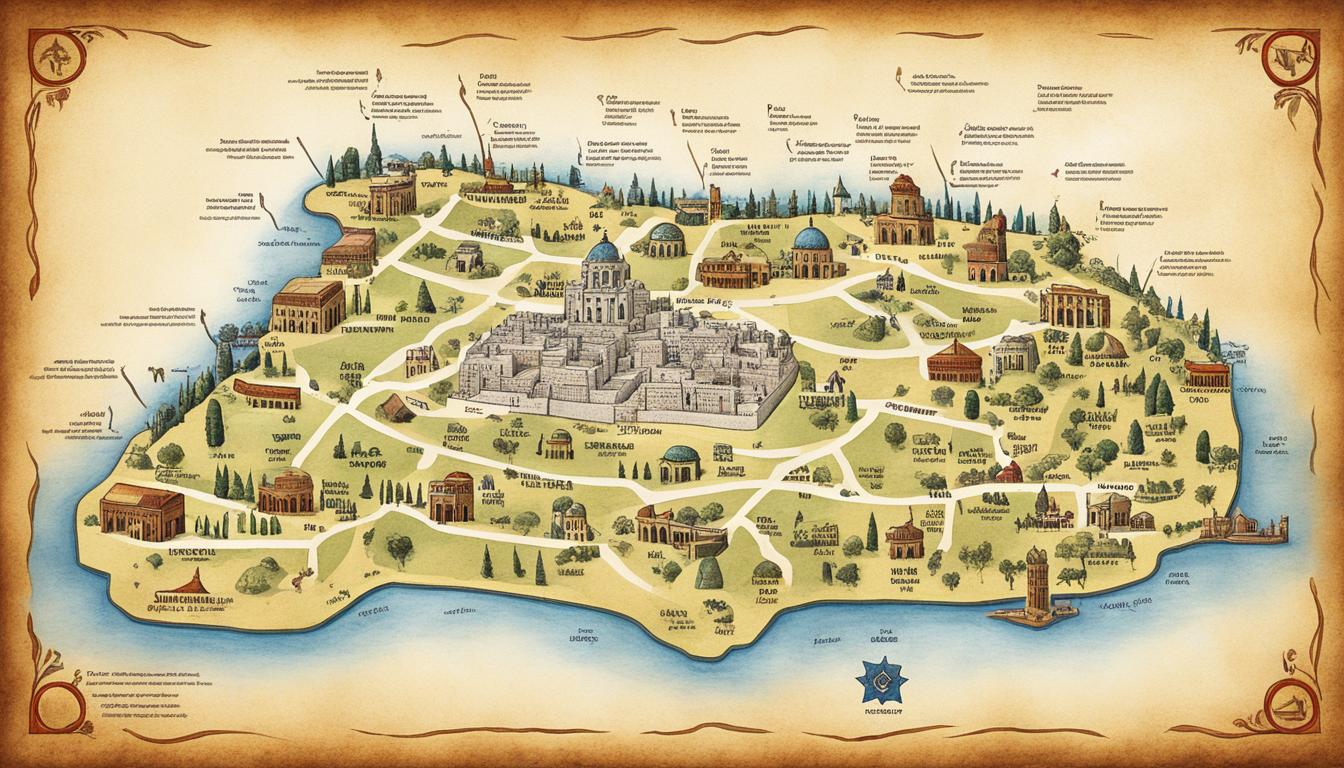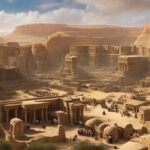The Twelve Tribes of Israel, also known as the biblical tribes or Israelite tribes, have a fascinating history that spans ancient Israel. These tribes are the descendants of Jacob’s sons and play a significant role in biblical genealogy. Understanding the boundaries and territories of each tribe is crucial in tracing their origins and exploring their historical significance.
Key Takeaways:
- The Twelve Tribes of Israel are the descendants of Jacob’s sons and are an integral part of biblical genealogy.
- Knowledge of the tribal boundaries and territories is essential to understanding their historical significance.
- These tribes shaped the culture and religion of ancient Israel, and their stories continue to impact religious practices today.
- Archeological evidence supports the existence of the Twelve Tribes and their ancient settlements.
- The journey of the tribes from Egypt to the Promised Land symbolizes faith and divine guidance.
Origins of the Twelve Tribes
The Twelve Tribes of Israel have a rich biblical genealogy that dates back to the origins of the Israelite tribes. According to the scriptures, these tribes are the descendants of Jacob, who was later renamed Israel. Jacob had twelve sons, each of whom became the founder of one of the twelve tribes. These tribes hold a significant place in biblical history and play a crucial role in the ancestral lineage of the Israelite people.
Descended from Jacob, the Twelve Tribes of Israel are an integral part of the biblical genealogy. Each tribe is associated with one of Jacob’s sons, and their names hold historical significance. These tribes are:
- Reuben
- Simeon
- Levi
- Judah
- Issachar
- Zebulun
- Dan
- Naphtali
- Gad
- Asher
- Joseph
- Benjamin
Each tribe has a unique history and played a significant role in shaping the Israelite nation. Understanding the origins of these tribes and their connection to Jacob provides valuable insights into the biblical narrative.
“And these are the names of the sons of Israel who came to Egypt, Jacob and his sons” (Exodus 1:1).
The biblical genealogy of the Twelve Tribes reflects the intricate family connections within ancient Israel. The descendants of Jacob formed a cohesive tribal structure that became the foundation of the Israelite society and culture.
Biblical Territories of the Twelve Tribes
In ancient Israel, the boundaries and territories of the Twelve Tribes played a significant role in establishing the tribal structure. According to the Book of Joshua, these territories were allotted by Joshua after the conquest of Canaan, based on God’s instructions.
Each tribe received a specific portion of land with defined boundaries, aligning with their ancestral lineage. The tribal territories formed the foundation of Israelite society, providing a sense of identity, security, and a connection to their heritage.
The allotment of these tribal territories showcased the divine guidance and order in establishing the Promised Land for the Israelites. It symbolized the fulfillment of God’s promises to the descendants of Abraham and their journey towards a prosperous future.
To better understand the tribal territories in ancient Israel, let us take a closer look at the boundaries of each tribe as described in the biblical text:
| Tribe | Boundary Description |
|---|---|
| Reuben | Located east of the Jordan River, their territory extended from the Arnon River in the south to the Jabbok River in the north. |
| Simeon | Situated within the territory of Judah, their portion was inserted between the portions of Judah and Benjamin. |
| Judah | Located in the southern region of Canaan, their territory extended from the Mediterranean Sea in the west to the Dead Sea in the east. |
| Issachar | Situated in the fertile plain of Jezreel, their territory was known for its agricultural richness. |
| Zebulun | Lying along the Mediterranean coast, their territory extended to the Valley of Jezreel and the Sea of Galilee. |
| Dan | Situated in the northern part of Canaan, their territory initially extended near the coast but was later relocated to the northern region of Laish. |
| Naphtali | Located in the hilly region of Galilee, their territory extended from the Sea of Galilee to the Mediterranean coast. |
| Gad | Situated east of the Jordan River, their territory extended from the Jabbok River in the south to the Sea of Galilee in the north. |
| Asher | Lying along the Mediterranean coast, their territory extended northward to the Phoenician cities of Tyre and Sidon. |
| Joseph | Composed of the tribes of Ephraim and Manasseh, the territory of Joseph extended from the Mediterranean coast in the west to the Jordan River and the Sea of Galilee in the east. |
| Ephraim | Located in the central region of Canaan, their territory was known for its fertile land and strategic position. |
| Manasseh | Divided into two portions, half of the tribe settled west of the Jordan River, while the other half settled east of the river. |
| Benjamin | Situated in the central region of Canaan, their territory extended from Jerusalem in the south to Bethel in the north. |
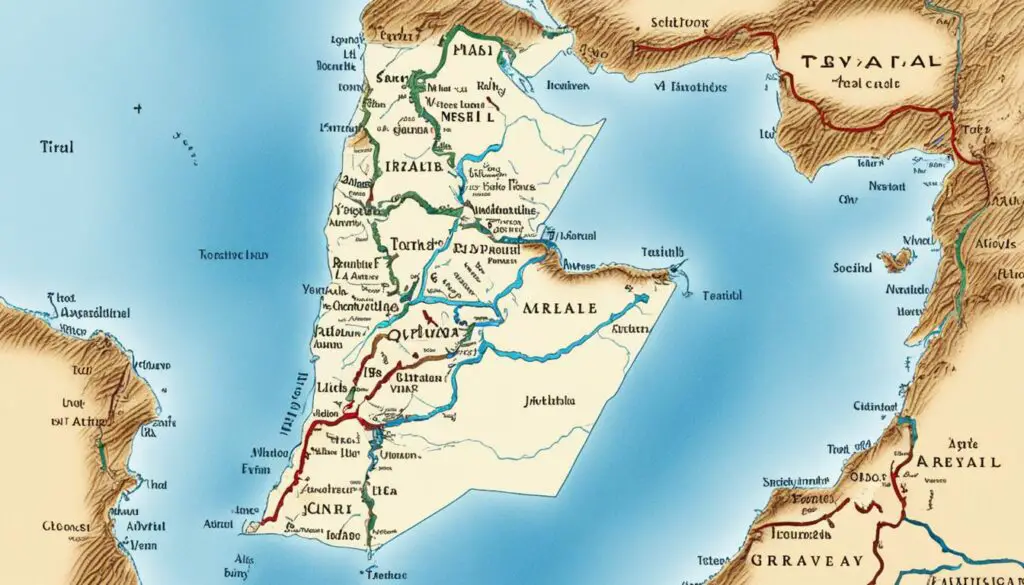
The ancient Israelite tribes and their respective territories hold immense historical and cultural significance. This distribution of land contributed to the formation of a cohesive tribal society, enabling each tribe to develop its unique identity and contribute to the overall fabric of Israelite civilization.
Join us in the next section as we explore the expansion and migration of the Twelve Tribes, uncovering the fascinating historical developments that shaped the ancient Israelite landscape.
Expansion and Migration of the Twelve Tribes
Over time, some of the Twelve Tribes expanded their territories or migrated to different areas. One notable example is the migration of the tribe of Dan, who ventured from their original land and settled in the northern region of Laish. This migration holds significant historical implications, particularly in the establishment of pagan shrines and the subsequent downfall of the northern tribes.
The Migration of the Dan Tribe
The migration of the Dan tribe is a fascinating chapter in the history of the Twelve Tribes of Israel. Moving away from their original territory, the Danites embarked on a journey that would shape their destiny and impact the surrounding regions.
Around the time of the Judges, the tribe of Dan found itself confined within their tribal boundaries, facing challenges such as the lack of sufficient land and limited resources. In search of better opportunities and fertile lands, a contingent of Danites set out on an expedition northward.
After traveling for a considerable distance, the Danites reached the region of Laish (also known as Leshem), located in present-day northern Israel. Mesmerized by the lush and abundant surroundings, they decided to establish their new settlement there.
This migration had both cultural and historical significance. The tribe of Dan, once settled in Laish, established pagan shrines and worshiped idols, deviating from the prescribed worship and adherence to God’s law. This departure from the true faith would eventually lead to dire consequences for the tribe and its neighboring communities.
“And the children of Dan set up for themselves the carved image, and Jonathan, the son of Gershom, the son of Manasseh, he and his sons were priests to the tribe of the Danites until the day of the captivity of the land.”
The migration of the Dan tribe not only altered the tribal boundaries but also introduced foreign practices and beliefs into the region. This migration, along with the establishment of pagan shrines, would later contribute to the downfall of the northern tribes and play a significant role in shaping the historical narrative of ancient Israel.
The Historical Significance
The migration of the Dan tribe carries a unique historical importance within the context of the Twelve Tribes of Israel. It highlights the complex interactions between different tribes and the consequences of straying from the true worship of God.
This migration is a reminder of the importance of adherence to God’s commandments and the consequences that can arise when tribes deviate from their prescribed boundaries and cultural heritage. The story of the Dan tribe serves as a cautionary tale, emphasizing the need for fidelity and faithfulness in maintaining the divine covenant.
The migration of the Dan tribe exemplifies the intricacies of tribal dynamics, shedding light on the historical development of ancient Israel. As we explore the heritage and accounts of the Twelve Tribes, it is essential to recognize the historical significance of such migrations and the profound impact they had on tribal boundaries, cultural practices, and the destiny of the Israelite people.
| Migration of the Dan Tribe: Key Points |
|---|
| Tribe: Dan |
| Original Land: Southern region of Israel |
| New Settlement: Northern region of Laish (Leshem) |
| Historical Implications: Establishment of pagan shrines, downfall of northern tribes |

Historical Significance of the Twelve Tribes
The legacy left by the Israelite tribes is one of profound historical significance. These tribes not only represent the ancestral roots of the Israelite people but also played a crucial role in shaping the cultural and religious aspects of ancient Israel. Through their stories and their relationship with God, the Twelve Tribes have left an indelible impact on the biblical narrative.
From the tribes’ struggles and triumphs to their exploration of faith and devotion, their stories continue to resonate with people across generations. The journey of the Israelite tribes reflects the trials and tribulations faced by individuals and communities throughout history, inspiring faith, perseverance, and hope.
“The tribes of Israel serve as a testament to the enduring power of faith and the strength that comes from unity.”
The cultural influence of the Twelve Tribes extends beyond their religious significance. Their traditions, customs, and moral teachings have had a lasting impact on the development of societal norms and ethical values. The tribes’ commitment to justice, kindness, and compassion continues to shape the collective conscience of modern society.
The impact of the Twelve Tribes on the biblical narrative cannot be overstated. Their struggles, victories, and spiritual experiences are woven into the fabric of the Old Testament, providing valuable moral lessons and guidance. The stories of individuals from each tribe highlight the complexity of human nature and the transformative power of divine intervention.
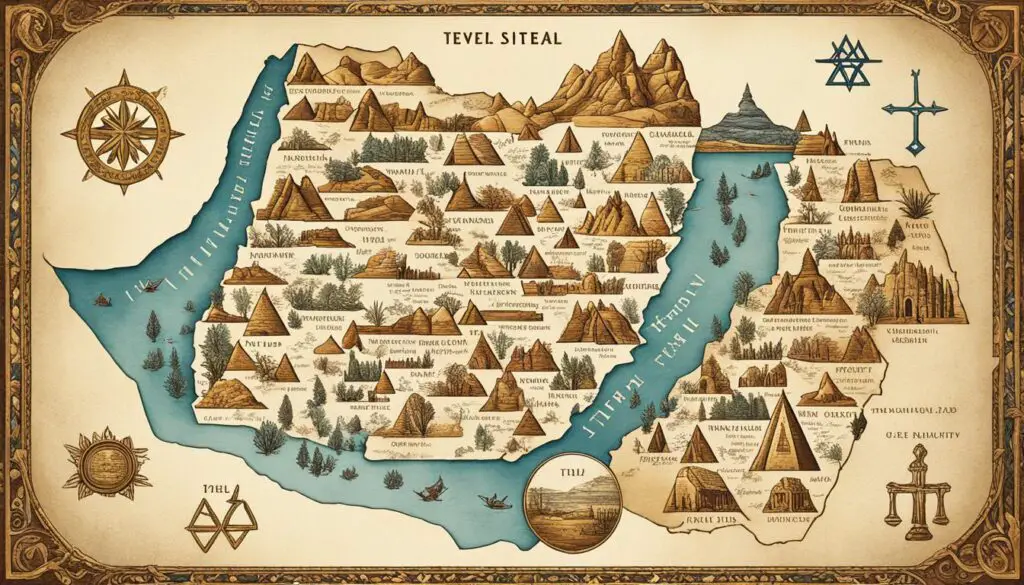
Moreover, the tribal system established by the Twelve Tribes influenced the political and social structure of ancient Israel. The tribes formed a cohesive framework that governed the allocation of resources, settlement patterns, and decision-making processes within the nation.
The legacy of the Israelite tribes continues to impact religious and cultural practices today. Their teachings and values, passed down through generations, resonate with individuals seeking spiritual guidance and moral clarity. The traditions of the Twelve Tribes serve as a reminder of the sacred connection between humanity and the divine.
| Legacy of Israelite Tribes | Cultural Influence | Impact on Biblical Narrative |
|---|---|---|
| Preservation of ancestral heritage and traditions | Shaping societal norms and ethical values | Weaving personal stories into the biblical tapestry |
| Inspiring faith, unity, and perseverance | Influencing political and social structures | Providing moral lessons and guidance |
| Resonating with modern religious and cultural practices | Impacting individual and communal identities | Highlighting the divine-human connection |
Archeological Evidence of the Twelve Tribes
Archeological excavations have unearthed fascinating evidence that supports the existence and locations of the Twelve Tribes of Israel. These excavations have provided valuable insights into the ancient settlements and tribal territories, validating the biblical accounts and shedding light on the historical presence of these tribes in ancient Israel.
Through meticulous digging and analysis of artifacts, archeologists have uncovered ancient settlements scattered across the land, offering a glimpse into the lives of the Israelite tribes. These settlements include remnants of dwellings, pottery, and other artifacts that provide tangible evidence of the ancient tribes’ existence.
Quote: “Our archeological findings paint a vivid picture of the Twelve Tribes of Israel and their presence in ancient Israel. The pottery and artifacts we have discovered not only align with biblical accounts but also reveal the daily lives and traditions of these tribes.” – Dr. Rachel Cohen, Lead Archaeologist
One of the most remarkable discoveries is the correlation between the archeological findings and the locations described in the Bible. The excavation sites align with the tribal territories as outlined in ancient texts, providing a tangible connection to the biblical narratives.
To reinforce this connection, the discovery of ancient boundary markers, inscriptions, and other markers has further solidified our understanding of the tribal locations. These findings not only authenticate the historical presence of the Twelve Tribes but also contribute to the broader context of ancient Israelite society.
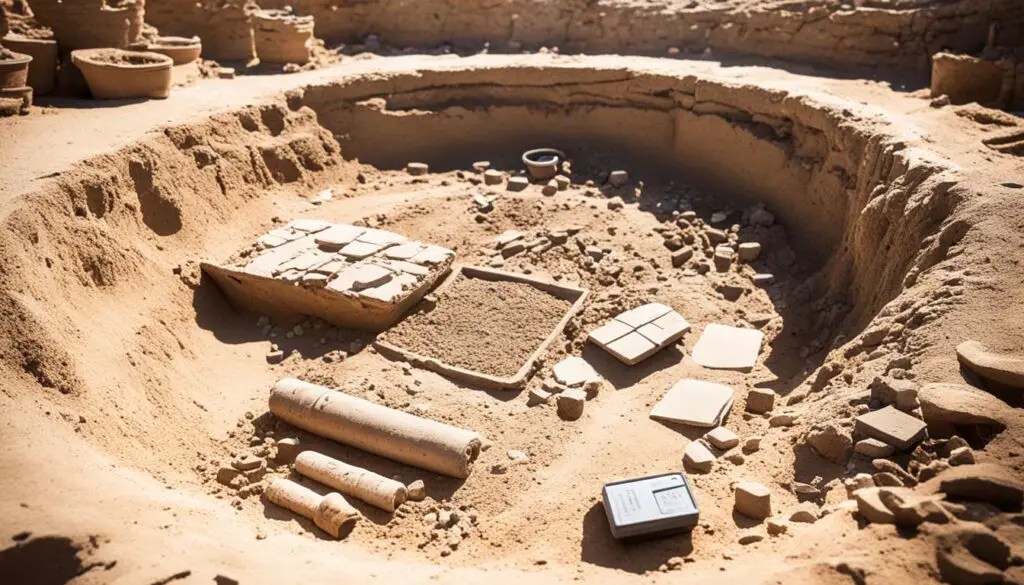
The image above showcases the meticulous archeological excavation process, uncovering artifacts that provide valuable evidence of ancient settlements and the locations of the Twelve Tribes.
Quote: “The archeological evidence we have gathered reaffirms the presence of the Twelve Tribes of Israel. These findings offer a unique glimpse into the rich history and heritage of the Israelite people.” – Professor David Kaplan, Archaeological Society
In conclusion, archeological excavations have yielded compelling evidence regarding the existence and locations of the Twelve Tribes of Israel. The discoveries made through these excavations, including ancient settlements, pottery, and other artifacts, provide valuable support for the biblical accounts and enrich our understanding of the historical presence of these tribes in ancient Israel.
The Journey of the Twelve Tribes
The journey of the Twelve Tribes of Israel is a remarkable tale of faith, perseverance, and divine guidance. It all began with their Exodus from Egypt, led by the great prophet Moses. This monumental event marked the liberation of the Israelites from slavery and the beginning of their journey towards the Promised Land.
After their miraculous escape from Egypt, the Twelve Tribes embarked on a long and arduous journey through the wilderness. This period of wandering, known as the wanderings in the wilderness, lasted for forty years. During this time, the Israelites faced numerous challenges, including scarcity of food and water, as well as external threats.
Their journey through the wilderness was not only a physical test but also a spiritual one. It was a time of learning and growth, as the Israelites forged a deep connection with their God and developed their faith. Despite the hardships they faced, their unwavering trust in divine guidance sustained them throughout their wanderings.
Finally, after four decades of wandering, the Twelve Tribes reached the long-awaited Promised Land. This land, flowing with milk and honey, was the fulfillment of God’s promise to their ancestors. In the Promised Land, the tribes established their tribal territories and began the process of building a homeland for themselves and future generations.
The journey of the Twelve Tribes from Exodus to their arrival in the Promised Land is an integral part of biblical history and holds deep spiritual significance. It symbolizes the power of faith, the importance of perseverance, and the fulfillment of divine promises. Through their journey, the Twelve Tribes of Israel left behind a legacy that continues to inspire people to this day.
| Event | Significance |
|---|---|
| Exodus from Egypt | Freedom from slavery and the beginning of the journey |
| Wanderings in the Wilderness | A time of testing and spiritual growth |
| Arrival in the Promised Land | Fulfillment of God’s promise and the establishment of tribal territories |
Genealogical Connections of the Twelve Tribes
The Twelve Tribes of Israel share a deep genealogical bond as descendants of Jacob, also known as Israel. Understanding their family connections and lineage provides valuable insights into the tribal structure and relationships within ancient Israel.
The tribes trace their origins back to Jacob’s twelve sons, each of whom became the founder of a specific tribe. These tribes form a cohesive unit, united by their common ancestry and heritage.
Through the genealogical connections, we can see how the descendants of Jacob formed distinct tribes with their own unique identities and roles within the larger Israelite community.
“The sons of Jacob are the ancestral roots of the tribes of Israel, and their genealogical connections create a strong bond among them.”
These genealogical ties shaped the foundation of the Twelve Tribes, and their interconnectedness fostered a sense of unity and shared destiny.
The Tribal Structure and Relationships
The genealogical connections within the Twelve Tribes of Israel had a significant impact on their tribal structure and relationships. The tribes were organized based on their lineage, with each tribe representing a distinct family unit.
These family connections not only influenced the territorial boundaries of each tribe but also played a role in their interactions and alliances. The lineage and shared ancestry formed the basis of relationships between the tribes, fostering a sense of camaraderie and mutual support.
“The genealogical connections provided a framework for the tribal structure, enabling the Israelite tribes to maintain strong family ties and navigate their shared history.”
The intricate web of family connections within the Twelve Tribes contributed to the social fabric and cohesion of ancient Israel, ensuring a collective identity and a sense of belonging.
Preserving the Family Connections
Over the centuries, the descendants of the Twelve Tribes have worked diligently to preserve their family connections and lineage. Despite the challenges of time and dispersion, many Jewish communities around the world still maintain a strong affinity for their tribal heritage.
Through customs, traditions, and genealogical research, these communities strive to keep their tribal identities alive and honor their Israelite ancestry.
“Preserving the family connections allows modern-day descendants to maintain a connection to their ancestral tribes and embrace their rich heritage.”
By embracing their genealogical connections, individuals and communities continue to celebrate the legacy of the Twelve Tribes and carry their traditions and values into the present day.
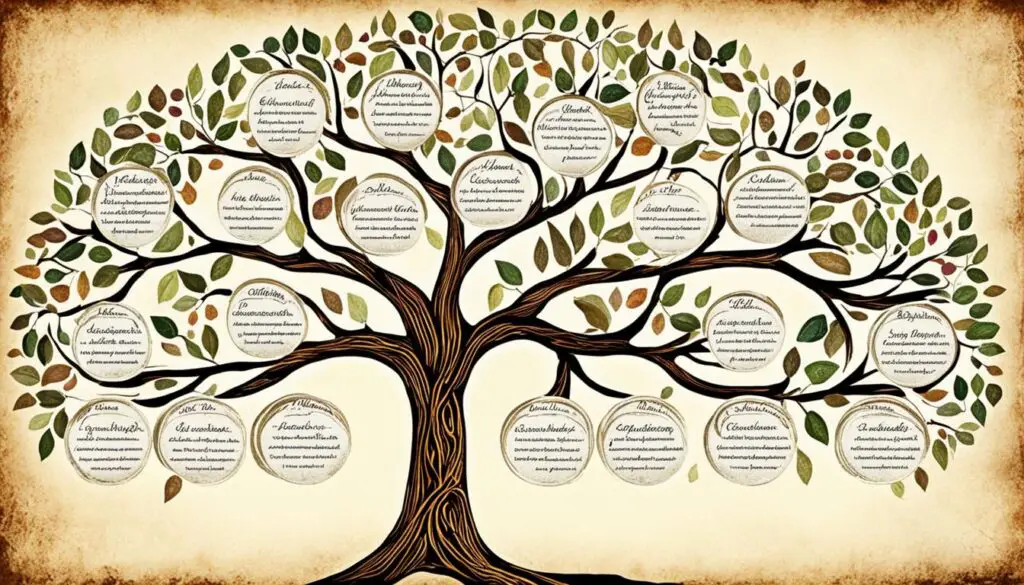
Role of the Twelve Tribes in the Kingdom of Israel
The Twelve Tribes of Israel played a pivotal role in the history of the Kingdom of Israel, shaping its political and religious landscape. Initially united under the rule of King David, the tribes held a significant position in the united monarchy.
As the united monarchy divided after the death of King Solomon, the tribes experienced a shift in power and influence. This division led to the downfall of the northern tribes, known as the Kingdom of Israel, and the establishment of the Davidic dynasty in the southern kingdom of Judah.
The division of Israel had enduring consequences for the tribes. The northern region, consisting of ten tribes, faced external threats and eventually succumbed to foreign invasions. On the other hand, the southern kingdom of Judah, with the tribes of Judah and Benjamin, continued the Davidic lineage, maintaining its political and religious sovereignty.
Division of the Kingdom of Israel
| Tribes | Kingdom of Israel | Kingdom of Judah |
|---|---|---|
| Ephraim | ✔ | |
| Manasseh | ✔ | |
| Reuben | ✔ | |
| Simeon | ✔ | |
| Issachar | ✔ | |
| Zebulun | ✔ | |
| Dan | ✔ | |
| Asher | ✔ | |
| Gad | ✔ | |
| Naphtali | ✔ | |
| Judah | ✔ | |
| Benjamin | ✔ |
The division of the Kingdom of Israel had a lasting impact on the tribes’ history. The northern tribes faced challenges from Assyrian invasions and ultimately lost their independence, leading to their assimilation and dispersal. In contrast, the Davidic dynasty of the southern kingdom of Judah continued for several more centuries.
“And when all Israel saw that the king did not listen to them, the people answered the king, ‘What portion do we have in David? We have no inheritance in the son of Jesse. To your tents, O Israel! Look now to your own house, David.’ So Israel went to their tents.” – 1 Kings 12:16
The role of the Twelve Tribes in the Kingdom of Israel showcases the dynamic nature of ancient Israel’s political and religious developments. The united monarchy under King David marked a period of stability and strength, while the subsequent division and establishment of the Davidic dynasty in Judah shaped the destiny of the tribes.
Tribes in Prophecy and Prophetic Literature
The Twelve Tribes of Israel hold a significant place not only in historical and biblical accounts but also in prophetic texts. Numerous references to the tribes can be found in the Old Testament and other ancient literature, providing insight into their future role and the restoration of Israel.
“The days are coming,” declares the Lord, “when I will bring my people Israel and Judah back from captivity and restore them to the land I gave their ancestors to possess” (Jeremiah 30:3).
Prophetic references often speak of a time when the scattered tribes of Israel will be gathered and reunited in their homeland. These prophecies offer hope and assurance that God has a future plan for the tribes, ensuring their restoration and the fulfillment of divine promises.
One notable prophetic text is the book of Ezekiel, where the prophet describes a vision of the future temple in Jerusalem. In this vision, the land of Israel is divided among the twelve tribes, representing the restored and reunited nation:
The Future Tribal Territories in Ezekiel’s Vision
| Tribe | Territory |
|---|---|
| Judah | South of Jerusalem, including the city itself (Ezekiel 48:8-22) |
| Benjamin | North of Jerusalem, between Judah and Ephraim (Ezekiel 48:23-27) |
| Joseph | Divided into two portions: one for Ephraim, the other for Manasseh (Ezekiel 48:4-7) |
| Dan | North of Benjamin, towards the east (Ezekiel 48:1) |
| Naphtali | North of Dan, towards the west (Ezekiel 48:3) |
| Reuben | South of Manasseh, towards the east (Ezekiel 48:6) |
| Simeon | Between Judah and the Dead Sea (Ezekiel 48:24) |
| Gad | North of Reuben, towards the east (Ezekiel 48:28) |
| Asher | North of Naphtali, towards the west (Ezekiel 48:2) |
| Issachar | North of Simeon, towards the west (Ezekiel 48:25) |
| Zebulun | North of Issachar, towards the west (Ezekiel 48:26) |
| Levi | Allotted various portions within the tribal territories for their service to the Lord (Ezekiel 48:10-14) |
This prophetic vision of the future tribal territories demonstrates the significance of the Twelve Tribes of Israel in God’s plan for the restoration of Israel.
In addition to the restoration of the tribes, prophetic literature also hints at their future role in the divine plan. These roles may include spiritual leadership, governance, and the establishment of justice in the restored nation of Israel.
As the prophecies unfold and the restoration of Israel takes place, the tribes will play a vital role in embracing their unique identities, continuing their legacy, and contributing to the fulfillment of the divine plan.
Modern Identity of the Twelve Tribes
The modern identity of the Twelve Tribes of Israel is a captivating subject that sparks scholarly inquiry and lively discussions. While establishing direct connections between modern individuals and specific tribes may pose challenges, many Jewish communities worldwide proudly preserve and celebrate their tribal heritage. These communities recognize their Israelite ancestry and safeguard cultural traditions passed down through generations.
Conclusion
The Twelve Tribes of Israel have a remarkable and enduring legacy in biblical history and religious traditions. From their origins as the twelve sons of Jacob to the establishment of their tribal territories in ancient Israel, their story holds great significance.
These tribes played a vital role in shaping the cultural, religious, and political landscape of ancient Israel, impacting the lives of countless individuals and communities. Their journey from the Exodus in Egypt to the Promised Land symbolizes faith, perseverance, and divine guidance.
Today, the legacy of the Twelve Tribes continues to inspire and guide millions of people around the world. Their story not only serves as a reminder of our shared heritage but also emphasizes the importance of faith and heritage in our lives. The enduring relevance of the Twelve Tribes underscores the divine plan and the significance of our spiritual connections.
FAQ
What are the Twelve Tribes of Israel?
The Twelve Tribes of Israel are the descendants of the twelve sons of Jacob, also known as Israel. These tribes are considered to be the ancestors of the Israelite people and play a significant role in biblical genealogy.
How can the origins of the Twelve Tribes be traced?
The origins of the Twelve Tribes of Israel can be traced back to Jacob, who later became known as Israel. Jacob had twelve sons, and each son became the founder of one of the twelve tribes.
What were the territories of the Twelve Tribes of Israel?
According to the Book of Joshua, the territories of the Twelve Tribes of Israel were allotted by Joshua after the conquest of Canaan. Each tribe received a specific portion of land with defined boundaries.
Did the Twelve Tribes of Israel expand or migrate?
Yes, over time, some of the tribes expanded their territories or migrated to different areas. For example, the tribe of Dan migrated from their original land and settled in the northern region of Laish.
What is the historical significance of the Twelve Tribes of Israel?
The Twelve Tribes of Israel were not only the ancestral tribes of the Israelite people but also played a crucial role in shaping the cultural and religious aspects of ancient Israel.
Is there any archaeological evidence of the Twelve Tribes?
Yes, archaeological excavations have provided valuable evidence regarding the existence and locations of the Twelve Tribes of Israel. Ancient settlements, pottery, and other artifacts have been discovered, supporting the biblical accounts and the historical presence of these tribes in ancient Israel.
What was the journey of the Twelve Tribes of Israel?
The Twelve Tribes of Israel began their journey with the Exodus from Egypt under the leadership of Moses. After years of wandering in the wilderness, they finally reached the Promised Land, where they established their tribal territories.
How are the Twelve Tribes interconnected?
The Twelve Tribes of Israel share a common ancestry and family connections as descendants of Jacob. These genealogical connections created a strong bond among the tribes.
What role did the Twelve Tribes play in the Kingdom of Israel?
The Twelve Tribes initially united under the rule of King David, but later experienced a division that led to the downfall of the northern tribes and the establishment of the Davidic dynasty in the southern kingdom of Judah.
Are the Twelve Tribes mentioned in prophecy?
Yes, the Twelve Tribes of Israel are mentioned in various prophetic texts, both in the Old Testament and other ancient literature. These prophecies often speak of the restoration and reunification of the tribes in the future.
What is the modern identity of the Twelve Tribes of Israel?
While it is challenging to establish direct connections between modern individuals and specific tribes, many Jewish communities around the world preserve and celebrate their tribal heritage, acknowledging their Israelite ancestry and preserving cultural traditions.
